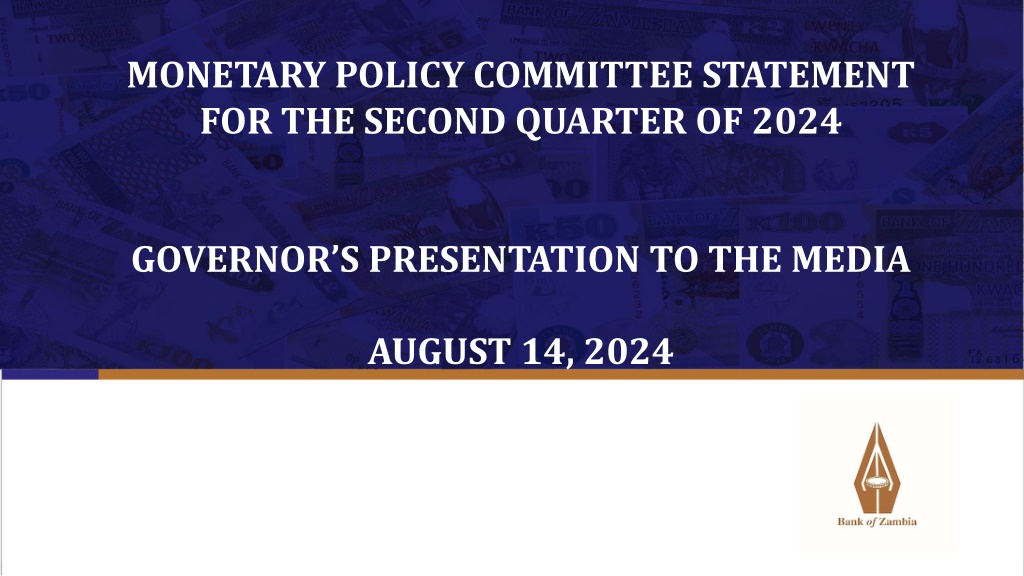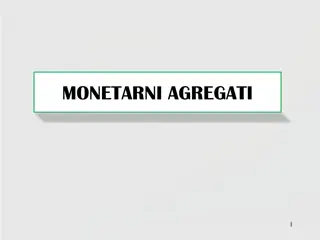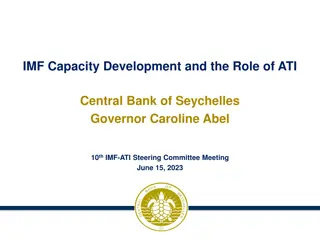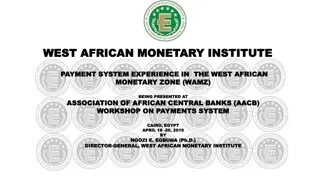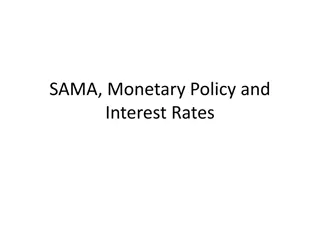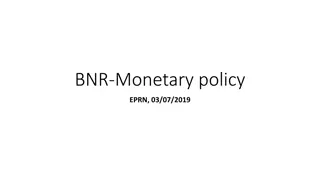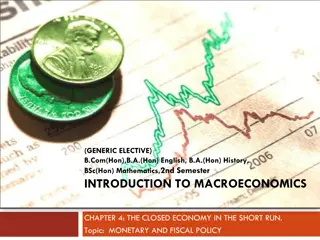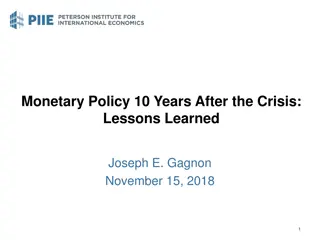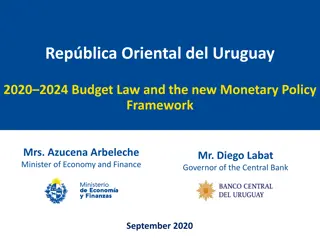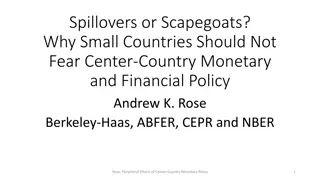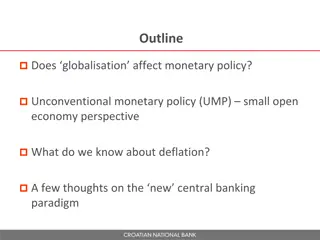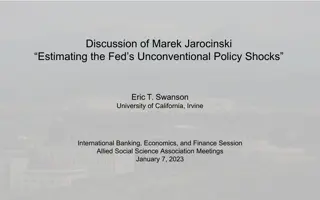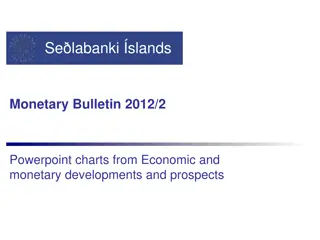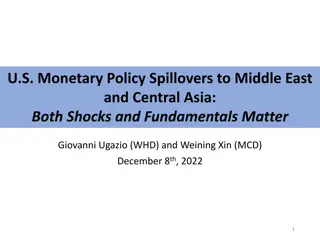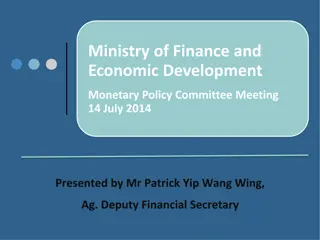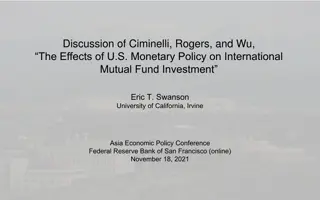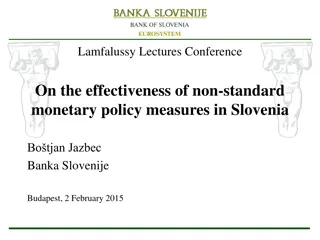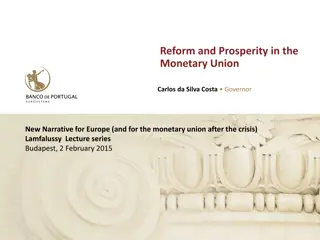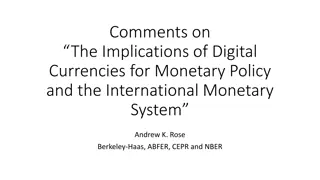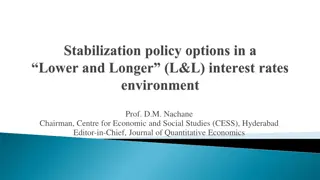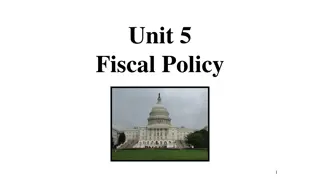Monetary Policy Committee Statement for Q2 2024: Governor's Presentation
The Monetary Policy Committee maintained the Policy Rate at 13.5% in the second quarter of 2024 despite elevated inflation. Inflation rose to 14.6% driven by Kwacha depreciation and food & energy price hikes. The decision considered the impact of the drought and previous policy adjustments. Key areas covered in the presentation include inflation outlook, foreign exchange market, credit developments, and economic activity evaluation.
Download Presentation

Please find below an Image/Link to download the presentation.
The content on the website is provided AS IS for your information and personal use only. It may not be sold, licensed, or shared on other websites without obtaining consent from the author. Download presentation by click this link. If you encounter any issues during the download, it is possible that the publisher has removed the file from their server.
E N D
Presentation Transcript
MONETARY POLICY COMMITTEE STATEMENT FOR THE SECOND QUARTER OF 2024 GOVERNOR S PRESENTATION TO THE MEDIA AUGUST 14, 2024
OUTLINE OF PRESENTATION 1. 2. 3. 4. 5. 6. Decision of the Monetary Policy Committee Inflation Outturn and Outlook Foreign Exchange Market Credit Developments Economic Activity Conclusion
DECISION OF THE MONETARY POLICY COMMITTEE At its Meeting held on August 12-13, 2024, the Monetary Policy Committee (MPC) decided to maintain the Policy Rate at 13.5 percent. oWhile actual and projected inflation remain elevated relative to the 6-8 percent target band, the Committee judged that the current monetary policy stance is appropriate. oThis decision took into account the impact of the drought as well as that of the past successive increases in the Policy Rate, upward adjustments in the statutory reserve ratio, and recent reforms in the foreign exchange market. oIn taking the decision to maintain the Policy Rate as opposed to raising it, the Committee also took into account the impact on the stability of the financial system and growth, particularly in 2024, in the wake of the drought.
INFLATION OUTTURN Average inflation rose further to 14.6 percent in the second quarter of 2024 from 13.5 percent in the first quarter of 2024 (Table 1). In July, annual inflation increased to 15.4 percent from 15.2 percent in June. The persistent depreciation of the Kwacha against major currencies, as well as rising prices of food (maize grain, maize products, and vegetables) and energy, particularly fuel, due to constrained supply continued to drive inflation in the second quarter (Charts 1 and 2).
INFLATION OUTTURN Table 1: Quarterly Average and end-Period Inflation Rate (percent) Average Overall Inflation Food Inflation Non-food Inflation Q2 2023 Q3 2023 Q4 2023 Q1 2024 Q2 2024 9.9 11.0 12.9 13.5 14.6 11.5 12.7 13.8 14.5 16.2 7.9 8.8 11.6 12.1 12.3 End Period Overall Inflation Food Inflation Non-food Inflation Q2 2023 Q3 2023 Q4 2023 Q1 2024 Q1 2024 9.8 12.0 13.1 13.7 15.2 11.2 13.4 14.2 15.6 16.8 7.8 10.1 11.6 11.2 13.0
INFLATION OUTTURN Chart 1: Contribution to Overall Inflation by Product in the Second Quarter of 2024 (percentage points) Chart 2: Contribution to Overall Inflation by Product in July 2024 (percentage points) Breakfast Mealie Meal Breakfast Mealie Meal Maize grain Roller Mealie Meal Roller Mealie Meal Mushrooms Sugar Sugar Maize cobs Maize grain Rice Imported Firewood Dried Kapenta Siavonga Rice Imported Bun Maize cobs Dried Kapenta Mpulungu Dried Kapenta Siavonga Bread Boom Boom Dried Kapenta Mpulungu Private house rent Charcoal Cooking oil Local Bun Frozen Fish Frozen Fish Charcoal Bread Cooking oil Imported Rape Dried Kapenta Chisense Cooking oil Local Butter Cooking oil Imported Fresh Milk Dried Kapenta Chisense Dried beans Fresh Milk Electricity Tariff R1 Toyota corolla Parafin purchases Eggs Diesel Mens trousers Imported Eggs Private house rent Rape Bar soap (Chik) Mini Bus Fare Nissan Pick Up Sweet potatoes Petrol Tomatoes Electricity Tariff R1 Bananas Domestic services Video cassette player Rice Local Foam Matress Diesel Mangoes Lifebouy Buka Buka Electricity Tariff R2 Blanket Toyota hilux Council house rent Cabbage Firewood 0.0 1.0 2.0 3.0 4.0 5.0 6.0 7.0 -0.4 -0.2 0 0.2 0.4 0.6 0.8 1 1.2 1.4 1.6
INFLATION OUTLOOK At the May MPC Meeting, inflation was projected to move into the 6-8 percent target band in the last quarter of 2025. The current forecast, however, points to inflation staying above the target band throughout the forecast horizon (Chart 3 and Table 2). Inflation for 2024 is now projected at 15.3 percent compared to 13.7 percent in May, largely reflecting the persistent depreciation of the Kwacha and the adverse impact of the drought on food and energy. Inflation is, however, forecast to moderate to 12.7 percent in 2025, albeit higher than the 9.8 percent reported in the May 2024 MPC Meeting. In the first half of 2026, inflation is expected to be 10.8 percent. The moderation in inflation is mainly on account of expected improvement in external sector performance and declining world food prices. Key upside risks to the inflation outlook remain broadly unchanged from May, but exacerbated by extended hours of electricity load management, as well as continued geopolitical conflicts and tight global financial conditions.
INFLATION OUTLOOK Chart 3: Inflation Outcome and Projection (percent) Table 2: Projected Average Inflation (percent) 2024 15.3 2025 12.7 2026 H1 10.8 16 August-2024 Projection May-2024 Projection 14 13.7 9.8 n/a 12 10 8 6 4 2022Q2 2022Q3 2022Q4 2023Q1 2023Q2 2023Q3 2023Q4 2024Q1 2024Q2 2024Q3 2024Q4 2025Q1 2025Q2 2025Q3 2025Q4 2026Q1 2026Q2 Target Range 2022 Inflation Target (9.9 percent) Actual Inflation May-24 MPC Forecast August-24 MPC Forecat
FOREIGN EXCHANGE MARKET Chart 4: Nominal K/US dollar Exchange Rate In the second quarter of 2024, the depreciation of the Kwacha against the US dollar moderated further to 3.8 percent from 10.6 percent in the first quarter (Chart 4). 30 15 10 25 5 The slowdown was attributed to improved supply of foreign exchange, particularly from the mining sector and moderation in demand. 20 0 15 In addition, the Kwacha was supported by positive market sentiments following further progress on external debt restructuring and the successful Third Review of the ECF Arrangement by the IMF Board on June 26. -5 10 -10 5 -15 Monthly Percent Change K/USD However, in the third quarter, the Kwacha has depreciated by 6 percent against the US dollar to K26.19 as at August 13 (Chart 4). 0 -20 Jul-22 Jul-23 Jul-24 Aug-22 Aug-23 Aug-24 Dec-22 Dec-23 Feb-22 Sep-22 Oct-22 Feb-23 Sep-23 Oct-23 Feb-24 Jan-22 Apr-22 Jan-23 Apr-23 Jan-24 Apr-24 Nov-22 Nov-23 Jun-22 Jun-23 Jun-24 Mar-22 May-22 Mar-23 May-23 Mar-24 May-24
FOREIGN EXCHANGE MARKET Chart 5: Mining Taxes Paid Directly to BoZ in US Dollars (US$ million) Mining tax receipts remitted directly to the Bank increased to US$252.5 million in the second quarter from US$190.8 million in the first quarter. 500 450 400 350 Due to improved supply, the Bank scaled down market support to US$275.0 million from US$369 million in the first quarter. 300 268.5 219.4 313.5 226.2 250 184.1 200 164.9 121.5 167.1 106.7 150 115.8 175.8 125.5 188.3 143.4 100 102.8 176.9 211.9 158.5 202.6 180.8 125.2 50 78.4 71.5 66.6 89.3 40.7 65.3 64.2 0 2021 Q1 2021 Q2 2021 Q3 2021 Q4 2022 Q1 2022 Q2 2022 Q3 2022 Q4 2023 Q1 2023 Q2 2023 Q3 2023 Q4 2024 Q1 2024 Q2 Mineral Royalty Non-Mineral Royalty
FOREIGN EXCHANGE MARKET Chart 6: Gross International Reserves Gross international reserves increased to US$3.9 billion (equivalent to 4.3 months of import cover) at end-June from US$3.6 billion (equivalent to 3.9 months of import cover) at end-March (Chart 6). This was mainly on account of the US$569.6 million disbursement by the IMF under the ECF arrangement. 4.5 6.0 4.0 5.0 3.5 3.0 4.0 2.5 3.0 2.0 1.5 2.0 1.0 1.0 0.5 In the second quarter of 2024, gold purchases amounted to US$8.6 million. This brings the total holdings to US$176.7 million since the Bank started purchasing gold locally. 0.0 0.0 Aug-22 Aug-23 Dec-22 Dec-23 Oct-22 Oct-23 Apr-23 Apr-24 Feb-23 Feb-24 Jun-22 Jun-23 Jun-24 Gross (Unencumbered Reserves & Encumbered Reserves at Market Rate in US$ billions) Months of import cover for GIR (RHS)
CREDIT DEVELOPMENTS Chart 7: Contribution to y/y Domestic Credit Growth Domestic credit growth picked up to 11.7 percent at end-June from 10.5 percent at end-March mostly due to increased lending to the private sector (Chart 7). 45.0 50.0 45.0 40.0 40.0 35.0 35.0 30.0 30.0 Percentage Points 25.0 Private sector credit expanded by 35.8 percent in June in nominal terms compared to 30.5 percent in March. 25.0 Percent 20.0 20.0 15.0 15.0 10.0 10.0 5.0 5.0 0.0 0.0 Lending Government securities contracted further as liquidity conditions remained broadly tight (Chart 7). to Government through -5.0 -5.0 -10.0 -10.0 Jun-19 Sep-19 Jun-20 Sep-20 Jun-21 Sep-21 Jun-22 Sep-22 Jun-23 Sep-23 Jun-24 Mar-20 Mar-21 Mar-22 Mar-23 Mar-24 Dec-19 Dec-20 Dec-21 Dec-22 Dec-23 Gross Claims on Central Government Private Sector Gross Domestic Credit Growth Rate (RHS) Exchange Rate Adjusted Domestic Credit
Non-Resident Holdings of Government Securities Chart 7: Non-resident holdings of Government securities Table 3: Non-Resident Holdings per Tenor as at end-June 2024 Holdings Per Tenor (K billion) 250 26 Tenor Percentage 25 200 24 150 3 Years 1.5 2.8 K' billion Percent 23 100 5 Years 9.4 17.2 22 50 21 7 Years 7.1 13.0 0 20 Apr-23 Apr-24 May-23 May-24 Mar-23 Mar-24 Jun-23 Jun-24 Feb-23 Sep-23 Nov-23 Feb-24 Oct-23 Aug-23 Jan-23 Dec-23 Jan-24 Jul-23 Jul-24 10 Years 26.4 48.2 Non-Resident Holdings (NRH) Total Outstanding Stock of Securities NRH Percent Share -RHS 15 Years 10.3 18.8
ECONOMIC ACTIVITY Economic activity remained weak in the second quarter as business conditions deteriorated in the wake of the adverse impact of the drought. Chart 8: Real GDP Growth Actual and Projected (percent) 8 6 4 Growth pessimistic with growth projected at 2.3 percent on account of the adverse impact of the drought on agriculture and energy sectors (Chart 8). prospects for 2024 remain 2 0 -2 -4 2024f 2025f 2026f 2023p 2015 2016 2017 2018 2019 2020 2021 2022 Growth is expected to rebound in 2025, attributed to the recovery in mining and agriculture sectors, and sustained expansion of ICT, financial and insurance, as well as wholesale and retail trade sectors. Bank of Zambia - July- 2024 (QPM) MoFNP - July 2024 FocusEconomics - August 2024 IMF WEO April 2024 Actual Real GDP growth
CONCLUSION The MPC decided to maintain the Monetary Policy Rate at 13.5 percent. While actual and projected inflation remain elevated relative to the 6-8 percent target band, the Committee judged that the current monetary policy stance is appropriate This decision took into account the impact of the drought as well as that of the past successive increases in the Policy Rate, upward adjustments in the statutory reserve ratio, and recent reforms in the foreign exchange market. In taking the decision to maintain the Policy Rate as opposed to raising it, the Committee also took into account the impact on the stability of the financial system and growth, particularly in 2024, in the wake of the drought. The continued implementation of fiscal consolidation measures, including completion of the external debt restructuring, and structural reforms remains critical to lowering inflation, maintaining financial stability, and creating an environment that promotes growth and resilience of the economy against shocks. In this regard, there is need for concerted effort and strengthened collaboration among all stakeholders to effectively address current and emerging shocks to safeguard macroeconomic stability. 9/24/2024 15
THANK YOU FOR YOUR ATTENTION. GOD BLESS
